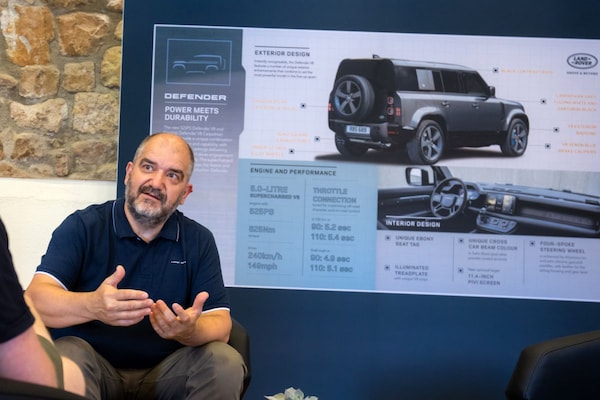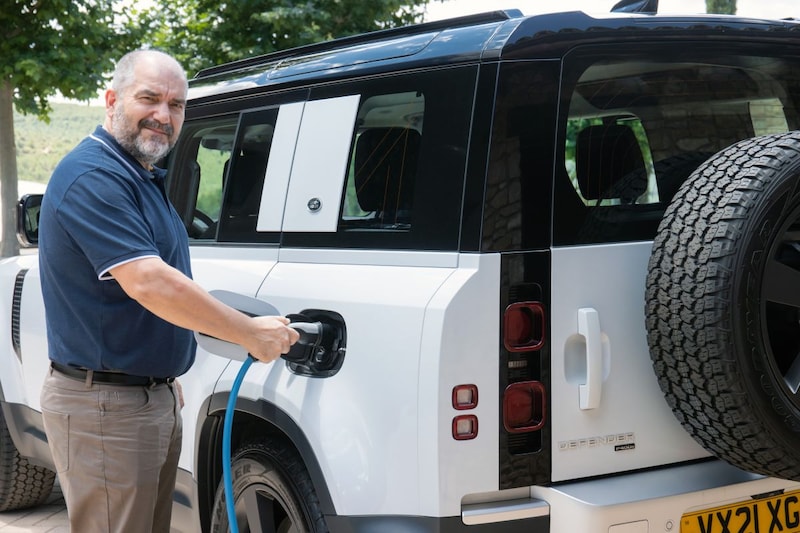Off-road icons also do not escape the greenhouse gas pressure imposed by the European Union. The PHEV version of the new Defender is a first step towards a cleaner future, an all-electric variant an inevitable second. Land Rover engineer David Hemming is already lifting a corner of the veil.
Offroaders and electrification: it sounds like an unlikely combination, but the Defender goes with the P400e on the plug.
“Is it really such an unlikely combination? At Range Rover, we have been offering plug-ins since model year 2019 that hold their own in the off-road. Although the new Defender towers above this in terms of 4×4 expertise, the operating principle remains the same. We therefore did not have to adjust the development because the combustion engine will now be accompanied by an electric motor and batteries. Better yet, the electrified Defender has to undergo exactly the same tests and tests as its conventionally motorized stable mates, so there are no compromises.”
Nevertheless, they have always taught us that water and electricity do not mix…
“At that point you have to make a double distinction: between passenger cars and 4×4 vehicles on the one hand, but also between plug-ins and EVs on the other. With the Defender, the car concept in itself is already equipped for water up to 80 cm deep. That means, by definition, most parts are packed waterproof to handle extreme off-road use. With our plug-in, the electric motor is also integrated in the transmission housing where the torque converter is normally located. The battery pack lies safely under the trunk and is also subject to extreme safety requirements, whether it is to be used for 4×4 applications or not. That makes the configuration of our PHEV fairly straightforward.”

Can we conclude from this that the arrival of a fully electric Defender is not so obvious?
“Although electric motors, and certainly individual wheel motors, unlock even more 4×4 expertise, full electrification also brings new challenges. We have to ask ourselves whether we want to meet that challenge with the current Defender platform. Technically it could be, but the question is whether that would also produce a better car than the current one. After all, we don’t want to compromise the ingrained talents of our all-rounder by cramming in five times as many batteries than the 19.2 kWh that the P400e now has on board. After all, such a modest battery pack has no negative influence on the driving capacities. It’s a first step, we need to explore the rest of the story.”
However, getting the emissions of the PHEV version below the tax-efficient limit of 50 grams of CO2 has not been successful.
“That’s right, with the P400e we are at 74 grams according to the WLTP measurement. In that respect we made a compromise between the mass of the vehicle, the weight of the batteries and the performance we wanted to achieve. Of course, under 50 grams would have been nice and especially interesting from a tax perspective in certain markets, but that turned out not to be feasible with this set-up. However, put yourself in the shoes of the user and you still buy a very interesting Defender, which has a lower running cost than the rest of the range and yet is not inferior in any way. That certainly makes the PHEV a relevant addition, regardless of its exact CO2 emissions.”
Meanwhile, Land Rover has announced an experiment with a hydrogen electric Defender. What are the plans with that?
“In mid-June, we indeed announced that we were going to build a development car with a hydrogen fuel cell. That prototype should be operational by the end of this year and fits in with our ambition to stop producing exhaust emissions from Land Rover vehicles from 2036. By 2039, our entire production chain must be CO2-neutral, which of course requires extra effort. FCEVs could be a solution for this, because hydrogen is very suitable for heavier vehicles and is also easy to refuel. We call it Project Zeus and it is a collaboration between Jaguar-Land Rover and many partners who believe hydrogen will play an important role in the future.”

It would also solve the problem of battery overweight in big cars like the Defender, wouldn’t it?
“Certainly, although that is by no means the only challenge. After all, it is not just about the vehicle or the precise powertrain, but about the entire infrastructure around it. If we bet on hydrogen, we have to be sure that there are enough filling stations for hydrogen. If we opt for batteries with a high energy density, then there should be fast chargers everywhere. These are all things that are far from being set in stone and that could change just like that, which is why we don’t want to get stuck today on one technology that should lead us to zero emissions by 2036. Moreover, it is a gradual process, starting with a PHEV and then evolving. That is better than offering the solution in one fell swoop. If we had all the wisdom in our hands now, it would be very easy.”
Meanwhile, the Defender V8 still looks good, but the question is of course how long that will be the case.
“We will do everything we can to keep this top engine in the range for as long as possible, albeit as a niche product, of course. This will take longer in some markets than others, for the simple reason that not all continents will switch from combustion engines to EVs at the same time. In the meantime, Defender customers enjoy more choice than ever before, with power ratings from 200 to 525 hp and both diesel and petrol engines with a plug-in option. If we can add an emission-free version in the future that fits the zeitgeist, the infrastructure and the ever-evolving use of buyers, I’ll be a happy man.”
– Thanks for information from Techzle.nl
